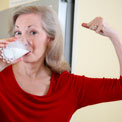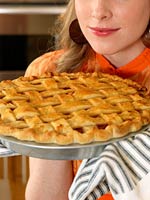Improve memory with scientifically designed brain exercises. www.lumosity.com
Yoga Teacher Training
Become a Certified Yoga Teacher in 90 Days or Less, in Your Own Home. www.yoga-teacher-training.org

The secret to a healthy body is simple and actually not too difficult, but all the same it does take daily discipline. In addition, it doesn’t need to cost you a lot of money. There are five areas of focus that will keep your body in shape, healthy, flexible, and strong. This article will outline the 5 areas to work on and will include a sample weekly workout regimen that you can start using today.
1. Aerobic Exercise. The simplest way to meet this need is walking. Walking is the one of the best exercises for your body. The wear and tear on your joints is lower than jogging. Be sure to start off slower to warm up and increase speed slowly after about 3-5 minutes. To increase the intensity, simply lengthen your stride a bit and speed up your pace. The other strategy for increasing intensity is to increase your speed for short bursts of time. (see workout below) If you prefer, jogging is also good if it doesn’t bother your knees. Just know that walking is just as good if you go fast enough. No big investment needed. All you need is your sneakers, and maybe not even that if you walk on the beach. 30 minutes per day every day has been shown to be the optimal amount of exercise. If you don’t have time all at once, the same benefits are derived even if you break it up into 3 X 10 minute or 2 X 15 minute sessions.
2. Stretching. An important age marker is your level of flexibility. Yoga is a terrific way to keep your body flexible. If you don’t have time for a full yoga session, try to make sure you do 5 minutes of stretching each day after your aerobic exercise. To ensure you get most areas of your body, try a sun salutation, some seated twists, and a hip opener.
3. Balancing. Balance, along with flexibility, is something that we lose with age. Practice this a little bit every day and you’ll be less likely to lose it. Yoga, again, is another great way to build and maintain balance. There are several yoga poses you could use to increase balance. Try one each day. A simple one you can do is to stand on one leg and grab the foot of the other leg to stretch the hamstring in the front of the thigh. As you build your balance over time try to touch your toes with your other hand while maintaining balance. It is helpful to keep your eyes focused on one point. Do this for 15-60 seconds on each leg.
4. Strength Building. You can certainly join a gym and lift weights. But another less expensive option, which is just as good, is simply using the weight of your own body for resistance. The easiest way to do this is to do an hour of yoga a few times per week. A yoga class is great, but to save money, I recommend buying a few different yoga tapes and rotate them. Check out tapes from your local library first to see if you like them before buying, or go to Amazon and check out the reviews to find ones that are highly rated. If you don’t want to do yoga, you can do pilates or try the free online workout regimen prescribed by Dr. Roizen and Dr. Oz of “YOU: The Owner’s Manual.”
5. Deep Breathing. This is very important and here’s why. Your lymph system relies on the contraction of muscles and breathing to move the fluids of the lymph system around the body. Why is this so important? The lymph system “has three interrelated functions: (1) removal of excess fluids from body tissues, (2) absorption of fatty acids and subsequent transport of fat, as chyle, to the circulatory system and, (3) production of immune cells.” So, how do you get your daily dose? Aerobic exercise, yoga, and/or try The Deep Breathing Exercise 2-3 times per day. Here’s how:
- Empty your lungs completely by pulling in your stomach while you exhale.
- Take a deep breath in.
- Hold for twice as long as it took to breathe it in.
- Exhale for 4 times as long as it took to breath it in.
- Do this 10 times.
- Enjoy the rejuvenation!
Weekly Exercise Regimen
Monday
- Deep Breathing Exercise (Morning, Afternoon, Evening).
- 30 minutes Walking at brisk pace.
- 5-10 minutes stretching.
- One balance pose.
Tuesday
- Deep Breathing Exercise (M,A,E).
- 45-60 minutes Yoga.
Wednesday
- Deep Breathing Exercise (M,A,E).
- 30 minutes walking with alternating 3 minute power bursts/3 minute moderate pace.
- 5-10 minutes stretching.
- One balance pose.
Thursday
- Deep Breathing Exercise (M,A,E).
- 30-60 minutes Pilates.
Friday
- Deep Breathing Exercise (M,A,E).
- 30 minutes walking.
- 5-10 minutes stretching.
- One balance pose.
Saturday
- Deep Breathing Exercise (M,A,E).
- 30 minutes walking.
- 20 minutes strength training.
- 5-10 minutes stretching.
- One balance pose.
Sunday
- Deep Breathing Exercise (M,A,E).
- 45-60 minutes Yoga.
Do you have tips for keeping your body healthy? What’s your weekly regimen? Please share in the comments!
K. Stone is author of Life Learning Today, a blog about daily life improvements. A few of her most popular articles are Ultimate Goal Setting Guide, So You Want to Be a Writer, Should You Start Your Own Work at Home Business?, and Top 10 Yoga Videos + Bonus Pilates Too.
Food & Recipes
Community Conversations
Have you ever tried to get someone you love to eat healthier? Tell us what worked!
Healthy Recipes
Thousands of quick and easy recipes for breakfast, lunch, dinner, and even dessert!
Read more
Food & Recipe Topics
Eating
Eating
We have thousands of recipes that will ensure you are eating delicious meals, salads, sandwiches, soups and even desserts. Each of our recipes is easy to follow and gets good food on the table fast.
Read more
Eating
Learn to Make Delicious Meals
Healthy cooking is simple when you’ve got fresh ingredients, a little time, and hungry mouths to feed. Use our easy menus and nutrition tips to make sure you’re getting healthy food at each meal.
Read more
Eating
The Best Foods for Your Health
Why is nutrition important? Because what you eat affects the way your body works and its ability to fight off infections and diseases. Here, we’ll break down all the nutrition facts and figures so you know how to get the vitamins and minerals you need. Plus we’ll answer your questions and decode common nutrition myths so you’re body is healthy and fit.
Read more
Eating
Step-By-Step Guides to Healthy Food
Dining out on a diet isn’t difficult—it just takes a little know-how. We’ll teach you what restaurants serve up healthy fare, as well as healthy grab-and-go choices at fast food chains. You’ll be able to spot nutritious menu items and downsive portions so that dining out is a relaxing experience.
Read more
- Foodie Friday: Nasoya TofuPlus
- America’s Top 10 Healthiest Fast Food Restaurants
- Foodie Friday: Kashi Berry Blossoms Cereal
HEALTHY BODY
You know how you feel about life when your body just doesn’t seem to be working right – kind of depressing… And you know your diet is lousy, you aren’t eating right, drinking enough water, or exercising. But, having a healthy body (or dealing with an unhealthy body) is very important in the prevention of depression and suicide. People who work to continually improve their (healthy) body are happier and more balanced people. I have never had a perfect body but I feel perfectly fine about my body. My goal is to always work toward improving the body I’ve been blessed with. For most of us it’s too expensive to visit doctors every time something goes wrong, but now, with the educational miracle of the internet, we can research solutions to most of our own, or our family’s, physical problems within minutes. There are some interesting links below you can check out as well as in the “Balance” VIP Links page. Be sure to check out the books from Amazon too. I’ve picked out books that I own myself or hope to own someday. Books are cheaper than doctors and more enlightening. Do all you can do for yourself and then consult with the talented doctors who are trained professionals when serious problems arise. Good luck in your Journey for a Healthy Body.
Lots of love from Brenda (Jared’s Mom)
GOAL SETTING FOR A HEALTHY BODY:
- What am I reading to support a Healthy Body?
- I Exercise _____ minutes a day. I exercise by __________.
- Am I staying healthy by taking time for my personal hygiene?
- Am I making good, natural eating choices with vitamins, & minerals?
- Have I found a sport or activity, that I enjoy, to help keep me in shape?
- Have I found a sport or activity I can do with others (family) that I enjoy?
- Do I keep up on the latest Health News so I can prevent sickness and stay healthy?
- Do I drink plenty of water each day?
What to put in your Herbal Remedies Kit, or,
Being Prepared for Anything!
- Here are some ideas for a home herbal remedies kit that could prevent a trip to the doctor. This kit should be a part of any Family Preparedness Plan.
The five basic supplements:
- Enzymes – Protein molecules that help digestion.
- Probiotics – To support the immune system.
- Minerals – Must be able to be absorbed without toxicity.
- Vitamins – Whole Food supplements.
- Antioxidants – Pine Bark or Grape Seeds for example.
Some of the specific natural remedies to have on hand:
- Marine Phytoplankton – A lonic Whole Food Tonic (Success Stories on PDF)
- Echinacea Angustafolia – For prevention, every illness, and colds.
- Colloidal Silver – For plague, viral and bacterial infections.
- Healing Salve – For cuts, scrapes; an example would be aloe vera gel.
- Relax Magnets – Not edible, but good for minor aches and bruises.
- Flaxseed oil – To help keep “regular”.
- St. John’s Wort or SAM-e – For Stress and the natural mood boost.
- Tea Tree Oil – For fungi and soothing effects.
- Aromatic Botanicals – Oils such as Lavender, and/or peppermint.
- Teas; Non Caffeine – No or low caffinated Green Teas for example.
RECOGNIZING A STROKE
(Sent to me by my attorney, Jay Leipham – Spokane WA.)Susie is recouping at an incredible pace for someone with a massive stroke all because Sherry saw Susie stumble – -that is the key that isn’t mentioned below – and then she asked Susie the 3 questions. So simple – – Susie failed all three so 911 was called.Even though she had normal blood pressure readings, she did not appear to be having a stroke as she could converse to some extent with the Paramedics. They took her to the hospital right away.
Sometimes symptoms of a stroke are difficult to identify. Unfortunately, the lack of awareness spells disaster. The stroke victim may suffer brain damage when people nearby fail to recognize the symptoms of a stroke. Now doctors say a bystander can recognize a stroke by asking three simple questions:
- Ask the individual to SMILE.
- Ask him or her to RAISE BOTH ARMS.
- Ask the person to SPEAK A SIMPLE SENTENCE.
If he or she has trouble with any of these tasks, call 9-1-1immediately and describe the symptoms to the dispatcher.After discovering that a group of non-medical volunteers could identify facial weakness, arm weakness and speech problems, researchers urged the general public to learn the three questions. They presented their conclusions at the American Stroke Association’s annual meeting last February. Widespread use of this test could result in prompt diagnosis and treatment of the stroke and prevent brain damage.
It seems like just yesterday that you had to coax your daughter to bathe. But then she turned 11 and started spending hours in the bathroom and sizing herself up in every mirror she passes. She seems consumed by her looks. What happened? And is it healthy?
As they approach the teen years, it’s common and natural for kids to become more interested in appearances — their own and others’ — seemingly all of a sudden. Their bodies are going through some big changes as they grow and go through puberty. As preteens change physically they become more aware of how they look.
Growing and puberty affect more than a preteen’s outward appearance — body image is affected, too. Having a healthy body image means that most of your feelings, ideas, and opinions about your body and appearance are positive. It means accepting and appreciating your body and feeling mostly satisfied with your appearance.
Developing a healthy body image happens over time. It can be influenced by experiences and shaped by the opinions and feedback of others and by cultural messages.
Body Image and Appearance
Body image can be especially vulnerable during the preteen and teen years because appearances change so much and cultural messages that fuel dissatisfaction can be very strong. Being criticized or teased about appearance can be particularly hurtful at this age.
Preteens and teens often compare their looks with others’ or with media images of the “right” way to look. In cultures in which looks seem to matter so much — and ideal images are so unrealistic — it’s all too common to be dissatisfied with some aspect of appearance.
But feeling too self-critical about appearance can interfere with body image. And poor body image can hurt a teen’s overall self-image, too.
Beyond Appearances
As teens mature mentally and emotionally, they will develop a more complex self-image — one that incorporates their interests, talents, unique qualities, values, aspirations, and relationships. But during the early teen years, the image they see in the mirror makes up a big part of their self-image.
And while it’s true that appearance isn’t everything, feeling satisfied with appearance means a lot. If you’re wondering why your child suddenly seems so focused on appearance, keep in mind that preteens are:
- Adapting to a new reflection. Spending extra time grooming, making comparisons with friends and celebrities, and experimenting with clothing, hair, and makeup can be ways of getting to know and like the new self reflected in the mirror.
- Making a fashion statement. When preteens and teens express their taste in clothes and hairstyles, they’re making statements about themselves. Experimenting with and defining their styles is one way to express their interests, personality, independence, and identity.
- Finding a way to belong. Peers, groups, and cliques — which take center stage during the teen years — can also play a role in heightening young teens’ concerns about appearances. Dressing a certain way might be a way of feeling included, fitting in, standing out, or belonging to a group of peers.
Boys and Body Image
It’s not just girls who become focused on appearance. Boys might not be as vocal about it, but they can worry just as much about their looks. They may spend the same amount of time in front of the mirror, weighing where to part their hair, what kind of product to use, assessing acne, and deciding whether or not to shave. And when your son emerges wearing pants that sag as if he hasn’t quite finished getting dressed, he may in fact have spent hours getting them to hang at that exact angle.
Self-Critical Feelings
Feeling satisfied with appearance isn’t always easy. Many kids who have positive body images become self-conscious or self-critical as they enter the teen years. It’s not uncommon for preteens and teens to express dissatisfaction about their appearance or to compare themselves with their friends, celebrities, or people they see in ads.
Our culture emphasizes the need to look just right. Ads for everything from makeup and hair products to clothing and toothpaste send messages that people need to look a certain way to be happy. It’s hard not to be influenced by that.
You might hear your son or daughter fret about anything from height and hair to the shape of their nose or the size of their ears — any aspect that doesn’t match the “ideal.”
Body shape and size can concern them, too. It’s important for preteens or teens to eat nutritious foods, limit junk foods, and get plenty of physical activity, but it’s not advisable for them to diet. Being overly concerned about weight, restricting food, or exercising excessively can be signs of an eating disorder. Talk to your doctor if you notice any of these signs in your kids.
Self-criticism that seems constant or excessive or causes daily distress that lasts might signal an extreme body image problem known as body dysmorphic disorder. This condition involves obsessions and compulsions about slight or imagined imperfections in appearance.
A Natural Transition
In most cases, the focus on appearance is a very natural and common part of becoming a teenager. Typically, these expressions of frustration resolve quickly and don’t warrant concern — just plenty of patience, empathy, support, and perspective from parents.
Still, parents can be frustrated when looks seem to matter so much to kids. It can be a delicate balance to help preteens feel confident and satisfied with their looks while encouraging them not to be overly concerned with the superficial. It’s important to encourage teens to take pride in their appearance but also to emphasize the deeper qualities that matter more.
Boosting Body Image
As preteens try on different looks, parents can help by being accepting and supportive, providing positive messages, and encouraging other qualities that keep looks in perspective. Be sure to:
- Accept and understand. Recognize that being concerned about looks is as much a part of the teen years as a changing voice and learning to shave. You know that in the grand scheme of things your daughter’s freckles don’t matter, but to her they might seem paramount. As frustrating as it can be when they monopolize the bathroom, avoid criticizing kids for being concerned about appearances. As they grow, concern about their looks will stop dominating their lives.
- Give lots of compliments. Provide reassurance about kids’ looks and about all their other important qualities. As much as they may seem not to notice or care, simple statements like “you’ve got the most beautiful smile” or “that shirt looks great on you” really do matter. Compliment them on other physical attributes, such as strength, speed, balance, energy, or grace. Appreciating physical qualities and capabilities helps build a healthy body image.
- Compliment what’s inside too. Notice out loud all the personal qualities that you love about your kids — how generous your son is to share with his little sister, the determined way that your daughter studies for her tests, or how your son stood by his best friend. Reassure them when they express insecurity. When you hear “I hate my hair” or “I’m so little,” provide valuable counterpoint.
- Talk about what appearances mean. Guide your kids to think a little more deeply about appearances and how people express themselves. Talk about the messages that certain styles might convey. One outfit may send the message “I’m ready to party!” while others might say “I’m heading to school” or “I’m too lazy to do laundry.”
- Set reasonable boundaries. Be patient, but also set boundaries on how much time your kids can spend on grooming and dressing. Tell them it’s not OK to inconvenience others or let chores go. Limits help kids understand how to manage time, be considerate of others’ needs, share resources, exercise a little self-discipline, and keep appearances in perspective.
- Be a good role model. How you talk about your own looks sets a powerful example. Constantly complaining about or fretting over your appearance teaches your kids to cast the same critical eye on themselves. Almost everyone is dissatisfied with certain elements of their appearance, but talk instead about what your body can do, not just how it looks. Instead of griping about how big your legs are, talk about how they’re strong enough to help you hike up a mountain.
Having a healthy and positive body image means liking your body, appreciating it, and being grateful for its qualities and capabilities. When parents care for and appreciate their own bodies, they teach their kids to do the same.











